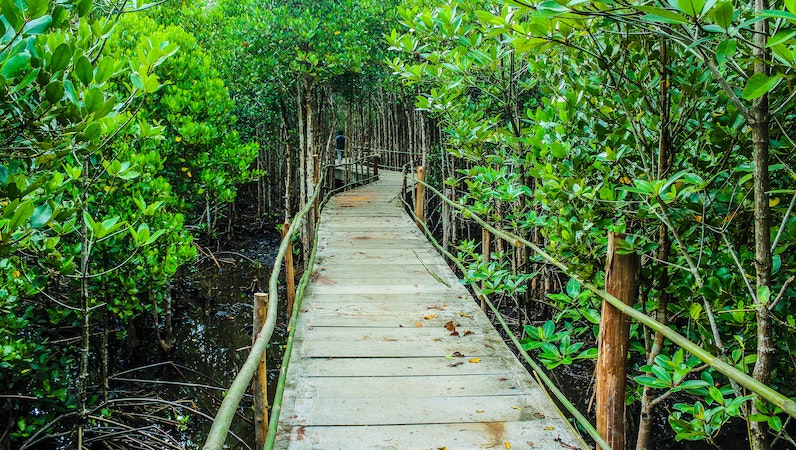“Private sector uptake of nature-based solutions for climate resilient infrastructure in Latin America and the Caribbean has been limited to date, and their full potential is not being realized.”
These are the findings from a recent study which examines the barriers and enablers to private sector uptake of Nature-based Solutions in Latin America and the Caribbean.
The project, a collaborative effort between the Inter-American Development Bank (IDB), the United Nations Environment Programme (UNEP), climate resilience consultancy Acclimatise, and the UNEP World Monitoring Conservation Center, aims to raise awareness of the range of benefits nature-based solutions will bring to the region.
But what are Nature-based Solutions?
The International Union for Conservation of Nature (IUCN) defines nature-based solutions as “actions to protect, sustainably manage, and restore natural or modified ecosystems, that address societal challenges effectively and adaptively, simultaneously providing human well-being and biodiversity benefits”.
More generally, ‘nature-based solutions’ is a term that can be used to describe alternative and non-traditional approaches to environmental issues, like flooding, water scarcity, or soil erosion, by harnessing natural capital.
Whilst the traditional method in infrastructural development is ‘gray’ – involving constructed and artificial structures – nature-based solutions encompass natural, green, and integrated infrastructure, which combines elements of all three.
Nature-based solutions disengage with the construction of seawalls, reservoirs, dams, and drainage systems that a gray infrastructure approach would take for certain climate risks.
Instead, nature-based solutions could include, restoring and conserving coral reefs and mangrove belts to enhance the resilience to coastal flooding and sea level rise, acting as a first line of defence to help dissipate wave energy; upsloping vegetation to reduce the risks of landslides; and creating permeable green areas to help replenish groundwater in regions facing water scarcity.

Why do they matter?
Nature-based solutions directly address a potentially unsustainable over-reliance on gray infrastructure.
The issue with gray infrastructure is twofold – it is reliant on the use of often unrecyclable and finite resources, and it is often temporary. As climate risks increase and intensify, gray solutions will need to be improved or replaced. Nature-based solutions also need to be maintained and sometimes restored, but not to the same extent, so can be more versatile than their gray counterparts.
By maintaining and replenishing natural elements, projects that integrate nature-based solutions help to conserve the environment, create habitats for endangered species, lower carbon emissions, and restore an aesthetic natural beauty to communities.
But natural capital has not been systematically incorporated into decision making and planning,” the IDB report argues. It says governments “do not always recognize dependencies on, or the economic contribution of, natural capital”.
This means countries are losing out on a key benefit of nature-based solutions: their economic value. Nature-based solutions have a higher resilience to climate change than gray approaches, so have reduced upfront capital costs, and reduced maintenance and operational fees.
So, what next?
Although nature-based solutions were featured as one of six priority Action Portfolios by Secretary General of the United Nations at the 2019 UN Climate Action Summit, gray infrastructure is still the traditional standard.
Discussions on nature-based solutions are happening, but IDB argues that not all the relevant party members are at the table. “In business, nature is often seen as a matter for Sustainability or Corporate Social Responsibility teams, rather than Executive Management Groups, and as relevant to conservation organizations rather than to project developers and professional associations,” IDB says.
The finance community also plays a crucial role. Leveraging private sector investment requires project developers to identify the revenue streams generated by the natured-based solutions component and incorporate it into the finance structure of projects. Making a clear business case will unleash the untapped potential that nature-based solutions bring for our region. With the interest of demonstrating that there are ways to monetize the benefits, the IDB is also investigating the financing models and structures of successful cases in LAC to bring light into this important dimension.
Referring specifically to Latin America and the Caribbean, the IDB report found that nature-based solutions are not typically mainstreamed into policy, legislation, and regulations.
In other areas of the world this is not the case. In the European Union for example, there are legal requirements for project developers to consider ‘reasonable alternatives’ as part of their environmental assessments.
This means that awareness of nature-based solutions globally, but especially in regions most acutely impacted by climate change, needs to be raised. This requires a strong business case, the provision of enhanced tools and methodologies for project members, and the development and implementation of suitable financing and insurance mechanisms, IDB argues.
The multi-functionality of nature-based solutions must be recognized, and only then will the required framework begin to take shape.
Read the publication here.
This post was sponsored by the Inter-American Development Bank. See our editorial guidelines for what this means.
